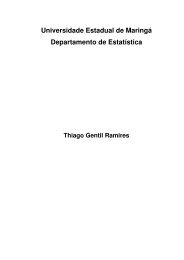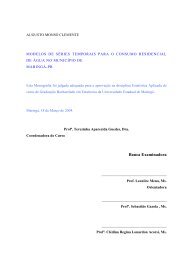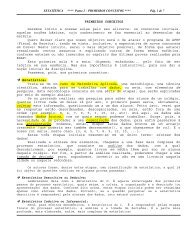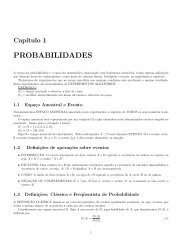Probabilidade de Cobertura dos Intervalos de Confiança ... - Uem
Probabilidade de Cobertura dos Intervalos de Confiança ... - Uem
Probabilidade de Cobertura dos Intervalos de Confiança ... - Uem
You also want an ePaper? Increase the reach of your titles
YUMPU automatically turns print PDFs into web optimized ePapers that Google loves.
2.4 Estimadores <strong>de</strong> Máxima Verossimilhança<br />
Os estimadores <strong>de</strong> máxima verossimilhança (EMV) <strong>de</strong> µ e β, são obti<strong>dos</strong> resolvendo itera-<br />
tivamente o seguinte sistema <strong>de</strong> equações não lineares<br />
⎧<br />
⎪⎨<br />
⎪⎩<br />
∂l(µ,β)<br />
∂µ<br />
∂l(µ,β)<br />
∂β<br />
β n = − µ i=1 δi + β n µ i=1<br />
β ti = 0<br />
µ<br />
1 n<br />
= β i=1 δi + n i=1 δi log( ti<br />
µ ) − n i=1<br />
β ti log µ<br />
<br />
ti = 0. µ<br />
(2.12)<br />
No software SAS, as estimativas <strong>de</strong> máxima verossimilhança po<strong>de</strong>m ser facilmente obti-<br />
das por meio <strong>dos</strong> procedimentos nlmixed, nlp ou iml uma vez especificada a função log-<br />
verossimilhança. O mesmo fato é válido, para qualquer função <strong>de</strong>nsida<strong>de</strong> <strong>de</strong> probabilida<strong>de</strong><br />
que não permita a obtenção <strong>dos</strong> estimadores <strong>de</strong> máxima verossimilhança analiticamente.<br />
2.5 <strong>Intervalos</strong> <strong>de</strong> <strong>Confiança</strong> Assintóticos<br />
<strong>Intervalos</strong> <strong>de</strong> confiança com coeficientes <strong>de</strong> confiança 100 × (1 − α)% para os parâmetros<br />
µ e β, po<strong>de</strong>m ser obti<strong>dos</strong> diretamente a partir da normalida<strong>de</strong> assintótica <strong>dos</strong> estimadores <strong>de</strong><br />
máxima verossimilhança (Guitany and Maller, 1992).<br />
<br />
IC(µ; 100 × (1 − α)%) = ˆµ ± zα/2 V ar(ˆµ),<br />
IC(β; 100 × (1 − α)%) = ˆ <br />
β ± zα/2 V ar( ˆ β),<br />
em que zα/2 é o α<br />
2 - ésimo percentil da distribuição normal padrão, e V ar(ˆµ) e V ar(ˆ β) são<br />
obti<strong>dos</strong> na diagonal principal do inverso da matriz <strong>de</strong> informação <strong>de</strong> Fisher (Ghitany amd<br />
Maller, 1992).<br />
Na prática, ao invés <strong>de</strong> se trabalhar com o inverso da informação <strong>de</strong> Fisher, trabalha-se com<br />
o inverso da matriz <strong>de</strong> informação observada. A matriz <strong>de</strong> informação observada localmente<br />
nos estimadores <strong>de</strong> máxima verossimilhança, po<strong>de</strong> ser escrita como:<br />
I(ˆµ, ˆ β|t) =<br />
⎡<br />
⎢<br />
⎣<br />
∂ 2 l(µ,β)<br />
∂µ∂µ | µ=ˆµ,β= ˆ β<br />
∂ 2 l(µ,β)<br />
∂µ∂β | µ=ˆµ,β= ˆ β<br />
∂ 2 l(µ,β)<br />
∂µ∂β | µ=ˆµ,β= ˆ β<br />
∂ 2 l(µ,β)<br />
∂β∂β | µ=ˆµ,β= ˆ β<br />
A inversa da matriz <strong>de</strong> informação observada é <strong>de</strong>finida como:<br />
I −1 (ˆµ, ˆ β) =<br />
<br />
V ar(ˆµ) Cov(ˆµ, ˆ β)<br />
Cov(ˆµ, ˆ β) V ar( ˆ β)<br />
15<br />
<br />
⎤<br />
⎥<br />
⎦ .<br />
. (2.13)






